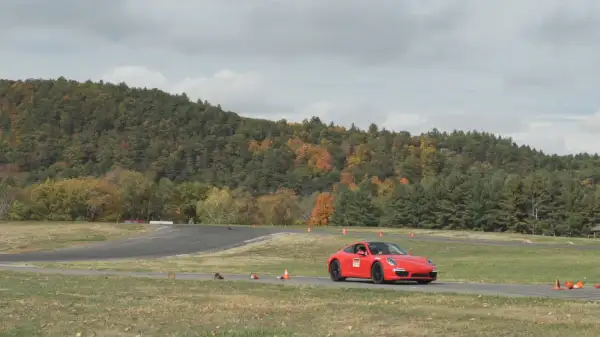The School That Teaches You to Drive Like a Race Car Driver

It’s not my habit to drive sideways. Having the rear wheels wander from their customary position until the car is fishtailing badly can’t be a good thing, can it? That’s not how my instructor viewed it when he yanked the parking brake of the Mazda Miata that I was driving, sending the car reeling. Think you’re such a hot shot driver—recover from this!
Now what? Brake, clutch, steering wheel, pedal: which do I operate and in what order? That becomes the immediate mission—in addition to dealing with the violence of the slide— but the whole nature of the dynamic driving course I’m taking at the Skip Barber Racing School is to teach you how to operate at the margins and even beyond. To understand concepts such as understeer and oversteer and the physics behind them. We’re on a skid pad—a relatively small circle of track that is purposely wet and slick— at the renowned Lime Rock Park, in Connecticut, where this session is taking place. I learn to swiftly maneuver the wheel using a “shuffle steering” technique to first counter the spin and then straighten the car. After a couple of attempts, it actually becomes fun and fulfilling as you corral your bucking Miata.
Skip Barber is one of a number of racing schools (Bondurant School, Allen Berg, Team O’Neil) that teach a range of driving skills, from basic driver ed for teens to three-day racing programs (about $4,000) and intensive race car training for your budding IndyCar career. In between, there are courses like high performance driving (about $1,500 for the day, plus insurance) that will help you explore the outer limits of your vehicle your abilities to handle same. We drove Miatas, Mustang GTs and Porsche 911s— that is, a Japanese sportster, American muscle and German finesse—through a series of exercises designed to teach the ultimate capabilities of today’s autos.
And those capabilities are beyond what you’d might expect. As an automobile reviewer, I try to push the performance of the cars I drive, but safely, and (mostly) within the rules of the road. Because that’s how you’ll drive them. (Members of the auto press, on the other hand, have been known to wreck test cars.) After all, do I really need to push the envelop on the Chrysler Pacifica’s cornering ability?
The Skip Barber course really imparts the idea that the average driver can do a lot more with his/her car. Especially with the brake pedal. The way to understand this is on the track when you are being encouraged to keep your foot on the accelerator longer than you think is safe as you head toward a turn— and then hammer the brake. “That’s a 6 on a scale of 10,” my instructor says on my first attempt to brake hard on the short autocross track. “I want an 8.” It’s a different feeling than everyday driving, in which you gradually decelerate into a turn. On a race course, that’s not the case—you’re trying to carry as much speed as you can as you exit the turn. The way to do that is take the correct line into the corner, brake briskly and brutally and then mash the accelerator again. When you get it right, there’s less of a sense of jolting the car to a near stop and then revving it again. You feel like you’ve tamed the beast, even as the tires are squealing and the brakes are smoking and you’re almost drooling with adrenaline. You now understand why people love to race cars. But that’s another course, isn’t it. Where do I sign up?
